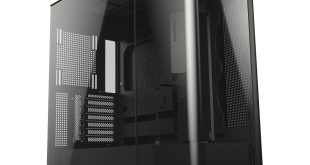Today we have built a high end system based around the Core i7 3960X Extreme Edition processor overclocked to 4.6ghz, with two Nvidia GTX590's running in Quad SLI formation. If the Cosmos II can keep this system in check then you can be sure that it will handle anything you can throw at it.
Processor: Intel Core i7 3960X Extreme Edition @ 4.6ghz (1.46v).
Motherboard: ASRock X79 Extreme 9 (full review forthcoming)
Cooler: Corsair H100 Liquid Cooler.
Memory: Corsair 8GB GTX8 DDR3 @ 2400mhz.
Graphics Cards: Nvidia GTX 590 in Quad SLI.
Power Supply: ADATA 1200W.
Boot Drive: Patriot 240GB Pyro SE SSD.
Windows 7 Enterprise Edition 64bit
Thermal Diodes
Raytek Laser Temp Gun 3i LSRC/MT4 Mini Temp
Digital Sound Level Noise Decibel Meter Style 2
Firstly let us have a look at the chassis design and airflow, as it comes ‘out of the box’. We received one of the first Cosmos II cases from the factory for this review today and the fan controller wasn't operational. We are therefore using the ASrock X79 motherboard to directly control all the case fans in the Cosmos II. Retail versions of the case will obviously not have this problem.
The front mounted 200mm fan pulls in a lot of cool from the front of the case, which is passed over the motherboard and components. The Corsair H100 exhausts hot air out the top of the case, with support from the 140mm rear mounted fan.
We have placed thermal diodes into 5 case positions. 1: at the top of the case, beside the optical drive bay. 2: beside the CPU cooler, next to the exhaust fans. 3: Next to the drive bay rack. 4: In the very center of the chassis, next to the graphics card. 5: close to the power supply, underneath the lower section of the motherboard.
Ambient room temperatures were maintained at 23c throughout.
The Intel Core i7 3960X EE was overclocked to 4.6ghz with 1.46voltage.
No performance related concerns with the processor holding well within the specifications we would expect. Diode temperatures were impressive throughout, especially as this ultra high end overclocked system radiates a lot of heat internally.
 KitGuru KitGuru.net – Tech News | Hardware News | Hardware Reviews | IOS | Mobile | Gaming | Graphics Cards
KitGuru KitGuru.net – Tech News | Hardware News | Hardware Reviews | IOS | Mobile | Gaming | Graphics Cards




